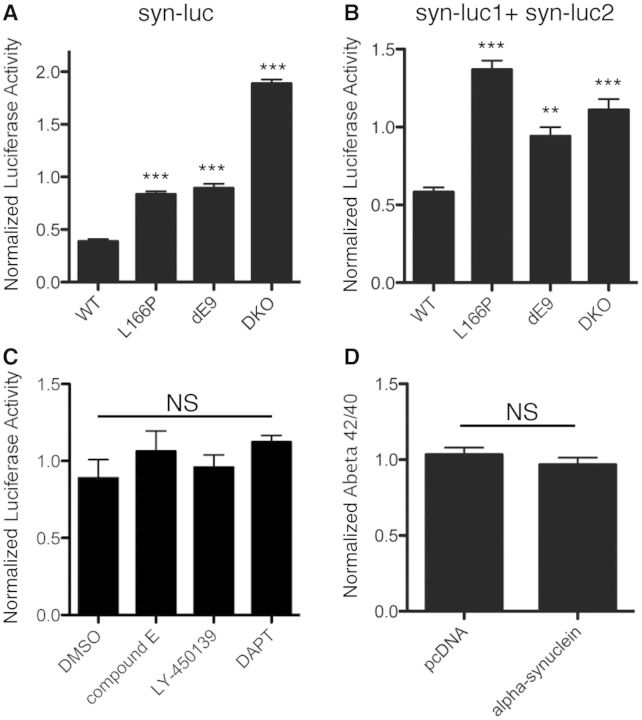Figure 5.
PSEN1 familial Alzheimer’s disease mutations cause increased α-synuclein accumulation. (A) PSEN1 mouse embryonic fibroblast cell lines were transfected with α-synuclein tagged with full-length lucifersase (syn-luc) and enhanced GFP as a transfection control. Luciferase and GFP levels for (A) and (B) were measured in each well for each condition and expressed as the mean and SEM of luciferase/GFP (n = 3, one-way ANOVA, Dunnett’s Multiple Comparison, ***P < 0.001). (B) PSEN1 mouse embryonic fibroblast cell lines were transfected with two α-synuclein constructs, one tagged with the N-terminus half of luciferase (syn-luc1) and one tagged with the C-terminus half of luciferase (syn-luc2), and enhanced GFP, to monitor complementation (oligomerization) of α-synuclein (n = 3, one-way ANOVA, Dunnett’s Multiple Comparison, **P < 0.01, ***P < 0.001). Mutant PSEN1 (L166P and dE9) or loss of PSEN1 increased the accumulation of total α-synuclein (A) and oligomeric α-synuclein (B) (as measured by luciferase activity/GFP levels). (C) Wild-type CHO cells were transfected with syn-luc1 and syn-luc2 and treated with γ-secretase inhibitors for 24 h. Inhibition of PSEN1 γ-secretase activity had no effect on the accumulation of oligomeric species (luciferase, mean and SEM) (n = 3, one-way ANOVA, Dunnett’s Multiple Comparison; NS = not significant). (D) CHO cells were transfected with either full-length, untagged wild-type human α-synuclein or empty vector pcDNA and amyloid-β40 and amyloid-β42 levels were measured by ELISA (mean and SD) from the conditioned media 24 h after tranfection. Overexpression of α-synuclein had no effect on the γ-secretase activity of PSEN1 measured indirectly by the amyloid-β42/ amyloid-β40 ratio [n = 2, t-test (on triplicate data sets), one-tailed, Dunnett’s Multiple Comparison, NS = not significant]. DKO = double knockout; DMSO = dimethylsulphoxide; DAPT = N-[(3,5-Difluorophenyl)acetyl]-L-alanyl-2-phenyl]glycine-1,1-dimethylethyl ester; CHO = Chinese hamster ovary.

